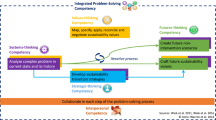Abstract
The present study investigated the impact of a Science, Technology, Engineering, Mathematics and Health (STEM+H) university-based pipeline program, the Careers in Health and Medical Professions Program, over the course of two summers among predominantly African-American high school students recruited from urban school districts (N = 155). Based on a mixed methods approach, results indicated that youth made significant gains in both academic and career knowledge. Furthermore, youth generally rated the program’s sessions favorably, but also rated sessions with varying levels of satisfaction. The limitations and implications for program delivery and evaluation methods among pipeline programs are discussed.
Similar content being viewed by others
References
Agrawal JR, Vlaciu S, Carrasquillo O (2005) Progress and pitfalls in underrepresented minority recruitment: perspectives from the medical schools. J Natl Med Assoc 97:1226–1231
Bhattacharyya S, Mead TP (2010) The influence of science summer camp on African American high school students’ career choices. School Sci Math 111:345–353
Bischoff PJ, Castendyk D, Gallagher H, Schaumloffil J, Labroo S (2008) A science summer camp as an effective way to major in the physical sciences and science education. Int J Environ Sci Educ 3:131–141
Danek J, Borrayo E (2012) Developing a health workforce that meets community needs. Coalition of Urban Serving Universities (USU), Urban Health Initiative (Report). http://community-wealth.org/sites/clone.community-wealth.org/files/downloads/report-danek-borrayo.pdf
Fields DA (2009) What do students gain from a week at science camp? Youth perceptions and the design of an immersive, research-oriented astronomy camp. Int J Sci Education 31:151–171
Furtak EM, Seidel T, Iverson H, Briggs DC (2012) Experimental and quasi-experimental studies of inquiry-based science teaching: a meta-analysis. Rev Educ Res 82:300–329
Gibson H, Chase C (2002) Longitudinal impact of an inquiry-based science program on middle school students’ attitudes toward science. Sci Educ 86:693–705
Marcelin G, Goldman L, Spivey WL, Eichel JD, Kaufman F, Fleischman AR (2004) The Junior Fellows Program: motivating urban youth toward careers in health, science, and medicine. J Urban Health 81:516–523
Markowitz DG (2004) Evaluation of the long-term impact of a university high school summer science program on students’ interest and perceived abilities in science. J Sci Educ Technol 13:395–407
Marrast LM, Zallman L, Woolhandler S, Bor DH, McCormick D (2014) Minority physicians’ role in the care of underserved patients: diversifying the physician workforce may be key in addressing health disparities. JAMA Intern Med 174(2):289–291
Michalek AM, Johnson CR (2004) Cancer research training for high school and college students at a comprehensive cancer center. J Cancer Educ 19:209–211
Miranda RJ, Hermann RS (2010) A critical analysis of faculty-developed urban k-12 science outreach programs. Perspect Urban Educ 7:109–114
Niemann MA, Miller ML, Davis T (2004) The University of Alabama at Birmingham Center for Community OutReach Development Summer Science Program: a 3-yr laboratory research experience for inner-city secondary level students. Cell Biol Educ 3:162–180
Oscos-Sanchez MA, Oscos-Flores LD, Burge SK (2008) The Teen Medical Academy: using academic enhancement and instructional enrichment to address ethnic disparities in the American healthcare workforce. J Adolesc Health 42:284–293
Padula CA, Leinhaas MM, Dodge KA (2002) Linking minority and disadvantaged high school students with health professions training: a win–win situation for students and older adults. Educ Gerontol 28:529–547
Perry JC, DeWine DB, Duffy RD, Vance KS (2007) The academic self-efficacy of urban youth: a mixed methods study of a school-to-work program. J Career Dev 34:103–126
Phillips JL, Blakely Harris T, Green Ihedigbo KM, Hawkins J (2012) Saturday morning science programs: a model to increase diversity in the biosciences. J Natl Med Assoc 104:377–383
Piburn M, Sawada D, Falconer K, Turley J, Benford R, Bloom R (2000) Reformed Teaching Observation Protocol (RTOP) (ACEPT Technical Report No. IN00-1). Arizona State University, Tempe, AZ
Porfeli EJ, Lee B, Vondracek FW, Weigold IK (2011) A multi-dimensional measure of vocational identity status. J Adolesc 34:853–871
Rao V, Flores G (2007) Why aren’t there more African-American physicians? A qualit-ative study and exploratory inquiry of African-American students’ perspectives on careers in medicine. J Natl Med Assoc 99:986–993
Rashied-Henry K, Fraser-White M, Roberts CB, Wilson TE, Morgan R, Brown H et al (2012) Engaging minority high school students as health disparities interns: findings and policy implications of a summer youth pipeline program. J Natl Med Assoc 104:412–419
Sikes SS, Schwartz-Bloom RD (2009) A science enrichment program for high school students. Biochem Mol Biol Educ 37:77–83
U.S. Department of Health and Human Services, Agency for Healthcare Research and Quality (2013a) Addressing racial and ethnic disparities in health care. http://www.ahrq.gov/research/findings/factsheets/minority/disparit/index.html
U.S. Department of Health and Human Services, Agency for Healthcare Research and Quality (2013b) National healthcare disparities report 2012. http://www.ahrq.gov/research/findings/nhqrdr/nhdr12/2012nhdr.pdf
U.S. Department of Health and Human Services, Health Resources and Services Administration (2006) The rationale for diversity in the health professions. http://bhpr.hrsa.gov/healthworkforce/reports/diversityreviewevidence.pdf
Winkelby MA (2007) The Stanford Medical Youth Science Program: 18 years of a biomedical program for low-income high school students. Acad Med 82:139–145
Winkleby MA, Ned J, Ahn D, Koehler A, Kennedy JD (2009) Increasing diversity in science and health professions: a 21-year longitudinal study documenting college and career success. J Sci Educ Technol 18:535–545
Acknowledgments
This work was supported by the Martha Holden Jennings Foundation and the Kaiser Foundation Health Plan of Ohio. The authors would like to thank Lauren O’Janpa, Danielle Meade, Christopher Williams, Jennifer Myers, and Timothy Trepal for their assistance with data collection and analyses.
Author information
Authors and Affiliations
Corresponding author
Rights and permissions
About this article
Cite this article
Wallace, E.W., Perry, J.C., Ferguson, R.L. et al. The Careers in Health and Medical Professions Program (CHAMPS): An Impact Study of a University-Based STEM+H Outreach Program. J Sci Educ Technol 24, 484–495 (2015). https://doi.org/10.1007/s10956-014-9536-2
Published:
Issue Date:
DOI: https://doi.org/10.1007/s10956-014-9536-2



